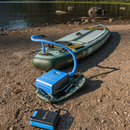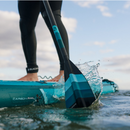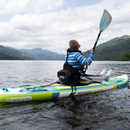A compact paddle board is popular among sports lovers because it's convenient and versatile. Unlike with the traditional rigid paddle board, you don't need to worry about where to store or how to pack the compact inflatable paddle board since it's lightweight and portable.
What Is a Compact Paddle Board?
A compact paddle board is a type of stand-up paddle board made for easy transport and storage. The compact boards are typically inflatable and can be rolled up to around half the size of a regular inflatable paddle board. The design makes them convenient for travellers and outdoor enthusiasts.
Here are our best compact paddle boards for you:
- iROCKER Cruiser Ultra
- iROCKER All Around 11’ Ultra
- BLACKFIN CX Ultra
- BLACKFIN MODEL XL 11'6"
- NAUTICAL GO TEN-SIX
1. iROCKER Cruiser Ultra
The CRUISER ULTRA™ 2.0 compact paddle board is a versatile and stable choice suitable for novice paddlers, intermediate paddlers, families with kids, and SUP yogis. Its 33”/84cm base and broad tail make it the most stable board on the market.
- Height:10'6" or 3.2m
- Tail Width: 20.6" or 52cm
- Thickness: 6" or 15cm
- Weight: 21 lbs or 10kg
2. iROCKER All-Around 11' Ultra
This compact inflatable paddle board offers improved stability and smooth glide with a new woven drop-stitch construction that enhances rigidity and stiffness. Its capacity allows solo riders or two smaller riders to perform. The product is designed for confident beginners or experienced paddlers.
- Height: 11' or 3.4m
- Tail Width: 18.6" or 47cm
- Thickness: 6" or 15cm
- Weight: 21.4 lbs or 10kg
3. BLACKFIN CX Ultra
For experienced surfers, the BLACKFIN CX ULTRA is a high-end, stable, and fast stand-up paddle board. Its integrated carbon rail and woven drop-stitch design offer superior tracking. 320 lbs./135 kg is the maximum weight capacity for adults, so they can ride alone or in pairs. The board performs exceptionally well on the water thanks to its lightweight carbon fiber paddle.
- Height: 10'6" or 3.2m
- Tail Width: 14.6" or 37cm
- Thickness: 6" or 15cm
- Weight: 19.8 lbs or 9kg
4. BLACKFIN MODEL XL 11'6”
This compact paddle board is suitable for both amateurs and experts. It features a 34"/86cm width a narrow tail, and an included Carbon Rail for added stiffness. With a weight capability of 485 lbs./220 kg, the board provides a balance between stability and speed.
- Height: 11'6" or 3.5m
- Tail Width: 18.5" or 47cm
- Thickness: 6" or 15cm
- Weight: 29 lbs or 13 kg
5. NAUTICAL GO TEN-SIX
For those looking for simplicity and ease in lightweight packaging, the NAUTICAL GO TEN-SIX compact inflatable paddle board with a minimalist design is the ideal choice.
- Height: 10'6" or 3.2m
- Tail Width: 24.15" (+/-) 1.5" or 61cm (+/-) 4cm
- Thickness: 6" or 15cm
- Weight: 20 lbs. (± .5lbs.) or 9kg (± 0.2kg)
What's the Difference Between a Compact Paddle Board and a Regular Paddle Board?
The main differences between compact paddle boards and standard regular stand up paddle boards are shown in the following table:
| Feature |
Compact Paddle Board |
Regular Paddle Board |
| Durability |
Durable despite their small size and innovative lightweight materials that ensure resilience and longevity. |
Stronger structure with more resistance provided by thicker materials. |
| Stability |
Generally stable, offering a thrilling challenge while maintaining balance, thanks to advanced engineering despite reduced length and width. |
Generally higher stability due to larger size and more surface area. |
| Performance |
Excels in versatile performance for various water adventures, delivering agility and responsiveness for spontaneous maneuvers while still maintaining speed and tracking capabilities |
Enhanced watercraft performance for speed, tracking, and maneuverability in various water conditions. |
| Portability and Travel Suitability |
Highly portable and suitable for travel due to compact size and lightweight design. Easy to transport in small vehicles or carry on public transport. |
More challenging for travel due to larger size and weight. May require roof racks or larger vehicles for transportation. |
| Storage |
Requires less storage space, suitable for apartments, small homes, or limited storage areas. |
Requires more storage space, typically stored in garages, sheds, or dedicated storage areas. |
| Price |
More affordable due to its smaller size and fewer materials used. |
Higher priced because of the larger size and more materials involved. |
| Setup Time |
Quick and easy setup due to smaller size and simpler design. |
Setup takes longer due to larger size and more components. |
| Repair/Maintenance |
Simpler due to fewer components, but compact boards may be more prone to damage. |
More complex due to larger size and more components, but generally less prone to damage. |
How to Choose a Compact Paddle Board?
Below is a guideline for selecting the perfect compact paddle board. Before making a purchase, you can ask yourself these questions to clarify your usage needs:
1. Is the Board Lightweight and Compact When Deflated?
When this type of board is deflated, it becomes lightweight and compact, making it convenient for travel. Pay attention to the pack size when carrying the board. If you’re biking or trekking, having a shorter pack that doesn’t hang down too far is essential for comfort. Regular boards require a pack that’s at least 38 inches long, while compact boards can fit into a 22-inch pack.
2. Does it Come as a Complete Kit?
Usually, all the equipment required for water sports, including a travel paddle, is included with a compact paddle board. Thus, it's very convenient for you to have this complete kit.
Besides, one more important thing to consider is the pump type. Making the decision between an electric pump and a manual pump is essential since; while electric pumps are simpler to use, they may not work at all without a car or battery. Compact boards with good manual pumps are advised for trips without electricity or for use in isolated areas.
3. Does It Come with a Good Quality Travel Bag?
For long-distance paddle board carrying, a comfortable and high-quality travel backpack is essential. Though it's lightweight, the board may become heavy for you after an hour of hiking. Thus, you should have a padded waist belt and adjustable straps for additional support. For short and slim individuals, the bag's length and strap adjustability are crucial.
4. How is the Performance?
In terms of speed and stability, the compact inflatable paddle board may not perform better than the regular one. Yet, compact boards have a lower weight capacity, which may be a concern for larger paddlers or those carrying heavy equipment. A regular inflatable SUP is recommended for those who don't mind weight and pack size. However, the weight and height of the rider affect how well a board performs. The ideal board will rely on your skill level and build.
5. How do I know what size paddle board I need?
The most common sizes for SUP boards are 32–34 inches wide and 10–11 feet long; a width of 33–34 inches is ideal for stability. Wider boards may result in sluggish and less enjoyable paddles, so it's essential to choose a board that suits your needs.
If you weigh less than 150 lb, go for a 9'6" board for portability and mobility. Choose a board with a width of 30-32 inches, as wider boards are slower to paddle.
Take into consideration a 12'6" touring or race board with a 32" width if you want speed and straight tracking and use a 30" board for steady touring. While 12'6" is a common length for SUP travel, storage issues could occur. Thus, go for models that are inflatable and provide great performance without storing problems.
A compact paddle board is a must-have item for all surfing lovers. It's lightweight, durable, and provides the necessary stability to conquer the waves. If you haven't had one, visit iROCKER right now. There is a long list of choices to satisfy all your needs.









